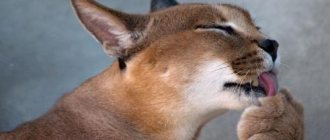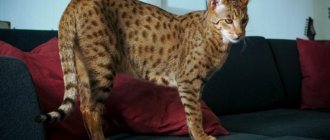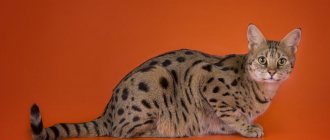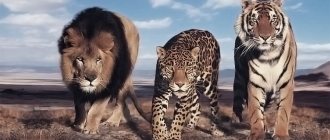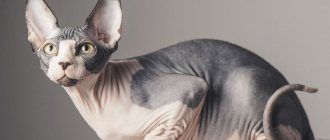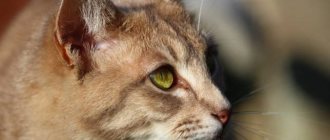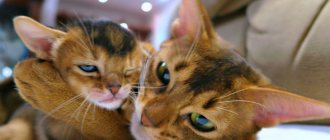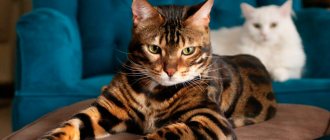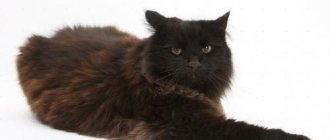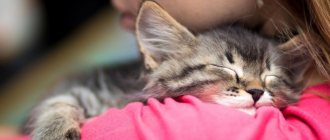Why do cats need ear tassels?
Initially, people assumed that the tassels on the ears did not carry any functional load and were simply decoration for the animal. In some cases, a cat with tassels on its ears is a sign of a purebred animal. But scientists, having studied the nature of felines, have put forward several theories that explain the presence of a unique “addition” on the animal’s ears.
The most popular version indicates that thanks to the tufts of hair at the tips of the ears, the cat’s hearing is significantly enhanced, allowing it to pick up even minor sound vibrations.
IMPORTANT: Maine Coon is the first cat breed to have ear tufts. The ancestors of the Maine Coon arrived in England on trading ships from the Scandinavian countries and settled in the harsh climate of the Isle of Man, where they continued to mix with native breeds.
At the beginning of their history, Maine Coons were not in demand due to the popularity of Persian cats
Lighthouse
According to one theory, the tassels on the ears serve as beacons for animals: in this way they can recognize each other in dense vegetation. This is especially true for animals that are forced to live in the wild and defend themselves from other predators.
Using tassels on its ears, an animal from a hiding place signals its presence to its relatives.
Determines the age of a cat
According to the second theory, the tassels on the ears determine the age of the animal: the thicker and longer the tassel, the older the cat.
Thick and long tassels indicate the pet’s age, but this is an unconfirmed fact.
Norwegian forest
This is a large, strong and very fluffy cat, on long muscular legs, with a triangular head, very large ears and lush “whiskers”, a feature of the breed. The Norwegians' thick coat has water-repellent properties, which was necessary for the survival of the breed's ancestors in the harsh climate of the Scandinavian Peninsula. But the character of Norwegians is not at all harsh: they are very smart, inquisitive, enterprising and sociable cats that get along well with all family members.
The breed was bred by breeders from Norway on the basis of semi-wild cats, inhabitants of forests (hence the name). Although it is often called aboriginal, this is not true: as studies have shown, Norwegians are distant descendants of Angoras, who somehow ended up, and what is important, perfectly adapted to the Scandinavian Peninsula.
What is special about these cats?
Exotic domestic cats received their unique appearance from their wild relatives. Thanks to breeders and selection, this feature has been successfully established and is passed on through genes from one cat parent to another. But a special appearance is far from the only sign of the individuality of such cats.
- Cats with tufted ears have a large, muscular build and a slightly wild and menacing appearance that attracts pet owners. The acquisition of such breeds is especially attractive for lovers of exotics, and the combination of brutal appearance and discreet character symbolizes the unity of wild nature with a strong attachment to humans.
The breeds are large in size
- The characteristic “wild” in the description of these animals has a special meaning. From their ancestors, these animals inherited not only tassels, but also a wayward, proud and independent character. This fact must be taken into account and educational measures must be applied correctly.
- Most of these cat breeds have long and thick hair, so caring for your pet will be especially thorough.
Caracal
These cats can hardly be called pets, because they are real wild animals that have been tamed by humans. Moreover, simply catching them in the wild and taming them will not work; it requires certain skills and painstaking selection work. Only kittens born in captivity can get used to human society.
Caracals are distinguished by their charm and insane beauty. Their ears are set high and have large and bright tufts. In young representatives the bristles stand upright, while in older representatives they gradually descend. It is preferable to keep caracals not in an apartment, but in a country house. After all, these animals really need freedom and constant movement.
Popular breeds
Among the most popular cat breeds with ear tufts, we highlight:
Maine Coon
This breed was first presented at an exhibition in Boston in 1861. The cat was distinguished by its unpretentious and calm character, as well as outstanding hunting qualities, thanks to which it settled on North American farms for a long time.
The owner of the Maine farm, Linda Choate, bred numerous offspring from two cats. Thanks to her, the new breed became known as the Maine Coon.
Maine Coons are distinguished by short, dense hair on the head, thick undercoat, wide paws and very long whiskers, which prevent them from bumping into branches in the dark.
IMPORTANT: there are several legends, in the first the Maine Coon is the result of crossing a lynx and a domestic cat, and the second believes that the stripe on the back indicates the crossing of indigenous breeds with a raccoon. The species differences of these animals deny such mixing.
Despite its harsh external appearance, the Maine Coon is a surprisingly intelligent, peaceful and domestic cat. Perhaps this is precisely what causes admiration for this breed: despite its wild appearance, the animal has a good nature that allows it to be strong friends with people and other domestic animals.
IMPORTANT: the largest Maine Coon is included in the Guinness Book of Records and weighs 16 kg.
Pixie Bob
Cats of this breed are very reminiscent of the North American lynx, and among breeders and breeders these pets are called “elves.”
The appearance of these cats is distinguished by a large body and paws, a well-developed muscular structure, the coat can be either long-haired or short-haired. The spotted color of the cat is a sandy or smoky tabby with uniform patches of dark color.
People call these cats “short-tailed elves”
Pixie-Bob has a wild and deep look, but despite this, the “elf” is a very friendly and patient pet who will willingly get along with children and other animals. With such an animal you will always be active: the breed requires the implementation of the hunter's instinct, as well as regular games in nature. Many owners note that Pixie-Bob often behaves like a very smart dog.
Norwegian Forest Cat
About 4-5 centuries ago, in the forests of Norway, wild native cats crossed with Angora cats, resulting in the appearance of the Norwegian forest cat.
This extraordinary breed has inherited the best qualities from its ancestors, and survival in harsh northern conditions has left its mark. The cat has long and thick hair, which will allow it to survive a very frosty winter. The peculiarity of wool is that it does not allow moisture to pass through and does not get wet when the cat moves through the snow.
The Norwegian Forest Cat is a true northerner
IMPORTANT: in Scandinavian mythology, Norwegian forest cats accompanied Thor himself, and during the Second World War the breed almost disappeared, but the Norwegian government made great efforts to restore the population.
Like previous breeds, the Norwegian Forest stands out for its large body and well-developed muscles. The ears are set wide apart, with small dense tufts of black hair at the tips. The cat has a very active, lively and peaceful character, thanks to which the fluffy northerner will become a faithful friend to his owner.
Caracal
The caracal is a steppe lynx that lives in wild fauna. To get a friendly and loyal friend, you need to raise the animal as a kitten. This is an extraordinary pet that has been identified as a separate species.
In the photo there is a caracal kitten, which at an early age resembles a baby puma or lynx
The animal resembles a lynx, but is closer in origin to a puma. The breed has a strong structure, well-developed muscles, a short tail and close-lying hair. The color of the animal's fur coat is usually uniform, red-brown with lighter coloring along the belly and tail.
Caracal has amazing and wild beauty
IMPORTANT: in Russia and especially in the CIS, caracal is a rarity. You can meet such a cat near the mountains and deserts of Dagestan.
The caracal is very hardy and peaceful, but the most important condition for this is the proper upbringing of the animal.
Siberian
The history of the breed begins in the 15th century and, according to one version, the Siberian, Persian and Angora breeds have one common ancestor. However, the Siberian cat was identified as a separate species, having gone through the harsh trials of the Urals and Siberia.
Like the Norwegian Forest Cat, the Siberian breed is very resistant to frost and wind; their coat has a thick double undercoat and is highly waterproof. This is a strong, robust and resilient cat, which has a very devoted character: it will patiently follow its owner, without requiring constant affection and increased attention. The breed has a highly developed hunting instinct; in a dangerous fight, a Siberian can defeat even a rat.
The hardy and reserved Siberian cat is very similar to its Norwegian “sister”
IMPORTANT: adult Siberian cats love to sit and lie on high places in the house, thus protecting the territory.
“Domestic lynx” – pixie bob
Born in 1986 in the United States, these short-tailed cats are considered a national treasure by many Americans. Outwardly, they look like a lynx; in fact, this was the task that the breeders set when creating this breed. They owe their name to a kitten named Pixie, which in English means “fairy” or “elf”. It was he who became the first successful result after many years of unsuccessful attempts to cross domestic cats with forest representatives of this family living in American and Canadian forests.
Pixie bob
These animals are often compared to dogs, and all because they are capable of becoming very attached to their owners and, in general, to the families in which they live. Not all of this quality is regarded as a virtue, because it is absolutely impossible to leave such a pet alone for a long time. Loneliness is contraindicated for pixie bobs. In the absence of a loved one for a long time, such an animal can fall into deep depression.
Representatives of this breed are flexible, affectionate and gentle. They love to spend time actively - playing, running, jumping. Such a pet will become a wonderful friend for a child. Aggression and vindictiveness are not about pixie-bobs. These animals get along well with other four-legged inhabitants of the house. However, there is a high probability that they will try to take a leadership position.
Cats of this breed can boast of good health, however, sometimes animals are born with extra toes. Unpretentiousness in food is another advantage of pixie bobs.
Wild cats with tassels on their ears
When mentioning the tassels on a cat's ears, the first thing many will think of is the lynx - this is a famous representative of the cat family.
The lynx has developed muscles and a strong body - without this it is impossible to survive in the wild. The northern cat, with its independent disposition, is small in size and chooses deep forests and taiga as its home. These cats are very active, they swim well, climb trees a lot and generally lead a sedentary lifestyle. Lynxes hunt at night and feed on hares, small ungulates and small rodents; occasionally a lynx can attack a wild dog or raccoon.
Lynx has several subspecies: common, Canadian, Pyrenean and red.
The Caracat is another breed that is considered rare and is the result of a cross between the Caracal and the Bengal cat. In the nursery of Irina Nazarova, from 2013 to 2021, 2 individuals of these cats were bred.
Caracat is a new breed of cat that has not yet become widespread
This breed has a strong body, a smoky or sand-colored coat, and a large size (an adult cat can weigh 15 kg). This is an energetic, intelligent and balanced hunter who can become an excellent companion. Keeping such an animal requires a large area and special conditions: the cat will eat only natural food.
At the moment, this breed is not in demand, as it was bred quite recently and has a high cost.
Features of maintenance and care
Cats with tufted ears, their types and breeds do not have radical differences from their counterparts: they are distinguished from other domestic cats by their brutal appearance, increased size and disposition.
These cats are not shy, patient and very calm: she will decorate your home with her presence, but will not intrude and demand attention. P
It is also worth noting that all of the listed breeds are active and have a pronounced hunter’s instinct, so the future owner will have to regularly play with the pet and give the animal’s strong body physical exercise in order to keep the muscles in shape.
Cats of these breeds are very friendly and do not show aggression without a serious reason.
Keeping such cats requires training from the first days of life: in this case, the animal will not exhibit wild habits and will become affectionate and domestic. You shouldn’t let the growing up period of “special” cats take their course: every pet requires good nutrition, regular care and sincere love from the owner.
Siberian beauties
Siberian cat This is one of the most popular cat breeds in Russia. She gained popularity due to the following qualities:
- Gorgeous thick fur.
- High intelligence.
- Balance that hides confidence and strength.
- Delicacy, sensitivity, tenderness, independence.
- Playfulness.
- Incredible devotion.
- Quite compact sizes, thanks to which the Siberian cat is suitable for keeping in a small apartment and a spacious private house.
- Long life expectancy. On average, representatives of this breed live about 17–20 years.
- Excellent health.
- Energy.
- Friendliness. Despite their friendly disposition, these cats are quite suspicious of strangers.
- Unobtrusiveness. Such a pet will never follow the owner's heels.
- The ability to get along in the same territory with other animals. This quality does not prevent the “Siberians” from repelling their fellow aggressors.
- Cleanliness. These animals keep their coats clean, but this does not eliminate the need for additional care.
- Wide variety of colors.
- Taciturnity.
- Undemanding to living conditions.
- Pronounced hunting qualities. This four-legged hunter will rid the house of rodents.
The disadvantages of this breed include:
- susceptibility to mood swings;
- a strong sense of self-esteem;
- love of heights;
- need for increased physical activity.
